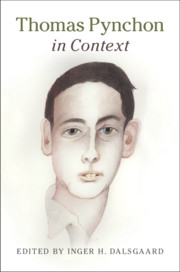Book contents
- Thomas Pynchon in Context
- Thomas Pynchon in Context
- Copyright page
- Contents
- Contributors
- Abbreviations
- Chronology
- Introduction
- Part I Times and Places
- Part II Culture, Politics, and Society
- Part III Approaches and Readings
- Chapter 34 Narratology
- Chapter 35 Genre
- Chapter 36 Postmodernism
- Chapter 37 Ambiguity
- Chapter 38 Realities
- Chapter 39 Material Readings
- Chapter 40 Digital Readings
- Chapter 41 Internet Resources
- Chapter 42 Fandom
- Chapter 43 Book Reviews and Reception
- Chapter 44 Critical Literature Review
- Further Reading
- Index
Chapter 35 - Genre
from Part III - Approaches and Readings
Published online by Cambridge University Press: 31 May 2019
- Thomas Pynchon in Context
- Thomas Pynchon in Context
- Copyright page
- Contents
- Contributors
- Abbreviations
- Chronology
- Introduction
- Part I Times and Places
- Part II Culture, Politics, and Society
- Part III Approaches and Readings
- Chapter 34 Narratology
- Chapter 35 Genre
- Chapter 36 Postmodernism
- Chapter 37 Ambiguity
- Chapter 38 Realities
- Chapter 39 Material Readings
- Chapter 40 Digital Readings
- Chapter 41 Internet Resources
- Chapter 42 Fandom
- Chapter 43 Book Reviews and Reception
- Chapter 44 Critical Literature Review
- Further Reading
- Index
Summary
Thomas Pynchon has penned short stories, essays, novels, introductions to novels by other writers, one introduction to the collection of his own stories, and liner notes. Yet, beyond this versatility, his refusal to editorialize or establish a unified, authoritative textual voice on whose judgment the reader can rely is conveyed by (among other things) the writer’s deployment of a wide variety of genres, and their complex enmeshing as well as transformations they undergo in his works. Whether his introduction to the collection of short stories, Slow Learner (1984), is a “preface, story [or] autobiography,” may be unclear, and Pynchon’s poetics and politics of genre reach an unprecedented level of sophistication and complexity in his novels. Fuzzily delineated, the genres he uses in his novels create generic hybrids and genre palimpsests. Broader generic categories appear alongside and merge with numerous subgenres familiar from the history of American canonical and popular literature. By parodying the familiar genres, Pynchon subjects to ideological critique the “literary tropes, cultural markers, and reading protocols” that make up those genre, thus playing with “the expectations, needs, or assumptions” of their users.
- Type
- Chapter
- Information
- Thomas Pynchon in Context , pp. 281 - 288Publisher: Cambridge University PressPrint publication year: 2019

